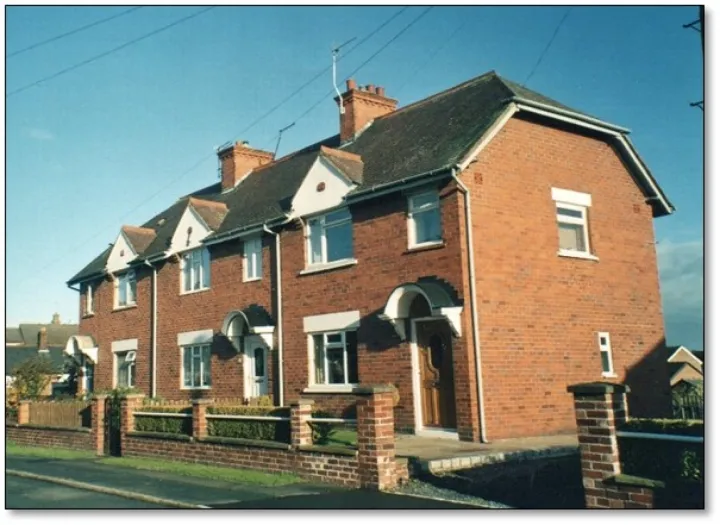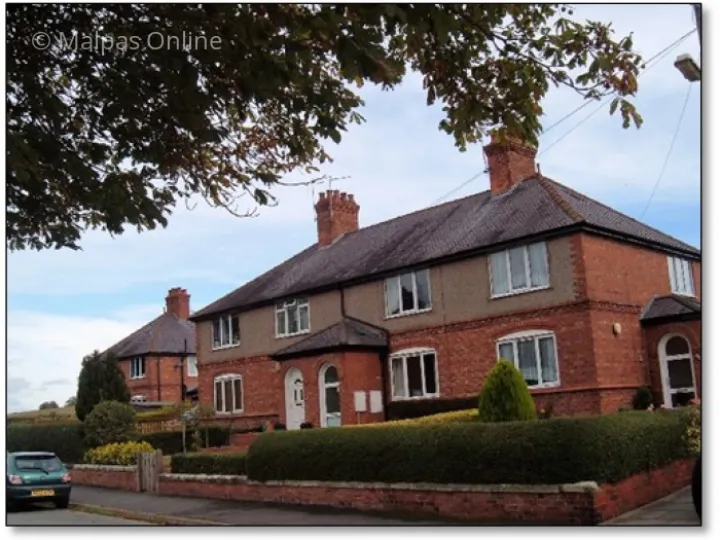Sunnyside Cottages 1906
Malpas Parish Council was formed under the 1894 Local Government Act.
Two years after the passing of the 1900 Housing of the Working Classes Act, the Parish Council decided to investigate the possibility of building twelve cottages.
The original plan was to build these cottages on the Moss Land situated just off the Whitchurch Road.
The Council approached agents for Squire Drake and Lord Cholmondeley to enquire if there was any likelihood that either landowner would be building any cottages in the near future.
The responses were negative and so it seemed that the only way in which new lower cost housing would be built in Malpas would be for the Parish Council to undertake the project itself.
However, plans were altered after the Council had called a meeting of ratepayers (i.e. a parish meeting) in October 1902.
It was to be another fifteen months before anything really started to happen. Then in March 1904 the Malpas Rural District Council (RDC) approved the first plans and resolved to apply for permission to take out loans over 60 years.
These were for £3,200 to acquire a site and to build twelve 'cottages' in Wrexham Road, and for £700 to acquire another site and build five cottages in Well Street.
Progress was rather slow until September 1905, by when the scheme for cottages in Well Street had been dropped.
The RDC had established a small Housing Committee, which was authorised to advertise in the local newspapers for a loan of £2,500 towards the Wrexham Road scheme, once it had been approved by the Local Government Board. Eventually the money was borrowed from Liverpool Corporation at a rate of 4% over 30 years.
Mr Philip Lockwood was appointed as architect.
As architect for Malpas RDC, he was instructed to seek tenders for building the Wrexham Road cottages.
Ten tenders were received and eventually the price of £2,108 to build the twelve houses (an average price of £176 per house), submitted by Malpas builder Thomas Huxley was accepted.
The 2½ acre site was purchased from Lord Cholmondeley for £80.
In May 1906 Thomas Huxley signed the contract with the RDC, which stipulated that the work must be completed within four months.
This seems an extremely short time to build the twelve 'Sunnyside Cottages', as they were called then, but by the following September they were indeed finished and tenants were being selected from the 19 who had applied for houses.
In October it was reported that all of the houses had been let, at weekly rents varying from 3s.9d (18p) to 4s.6d (22½p).
The three blocks of solidly built houses, each of four dwellings, still stand.
They remained the responsibility of Malpas Rural District Council until 1936. Then they passed to Tarvin Rural District Council until 1972, when they were taken over by Chester City Council, the new District Council formed as a result of the 1972 Local Government Act.
.
Malpas Rural District Council.
Malpas Rural District Council had been very far-sighted in erecting such an early set of local authority or 'council' houses. Before the First World War, council house building in rural areas was very limited.
Only 470 rural houses were built across the whole country which means that the twelve built at Sunnyside in 1906 represent about 1 in 40 of the national total.
Why the Council was so enthusiastic about the Sunnyside project is not clear from its minute books.
However, there seem to have been around 25 councillors in all and from evidence in local directories, 14 of them were farmers. Therefore, could it be that they saw council housing as a possible future solution to providing accommodation for farm workers, in cases where their own tied cottages were becoming dilapidated and expensive to maintain or replace?
By 1921, ten more houses had been built by the RDC, in semi-detached pairs, at Sunnyside and four more at The Oathills.
The last houses erected in Malpas township by Malpas Rural District Council were built in 1933, which included eight properties in Well Avenue (known initially as 'Council' Avenue) four close by at Well Meadow and also at Kidnal and Edge.
All completed before Malpas RDC was absorbed into Tarvin RDC in 1936.

.
Malpas Parish Council still owned two cottages in 1949, when it was agreed to apply to the Ministry of Health for permission to sell them to Tarvin Rural District Council, which was then the Housing Authority for the area.
Permission was given and the two, in Well Street and Tilston Road, were sold to the Tarvin Rural District Council for the nominal sum of £5.
The one in Well Street has been demolished but this one in Tilston Road, much altered since the sale and now privately owned, still stands.
.
Article compiled and published in March 2023 by Chris Whitehurst with information provided by David Hayns
Updated 3rd January 2026
Quick Links
Village Map
Get In Touch
MalpasOnline is powered by our active community.
Please send us your news and views using the button below:


